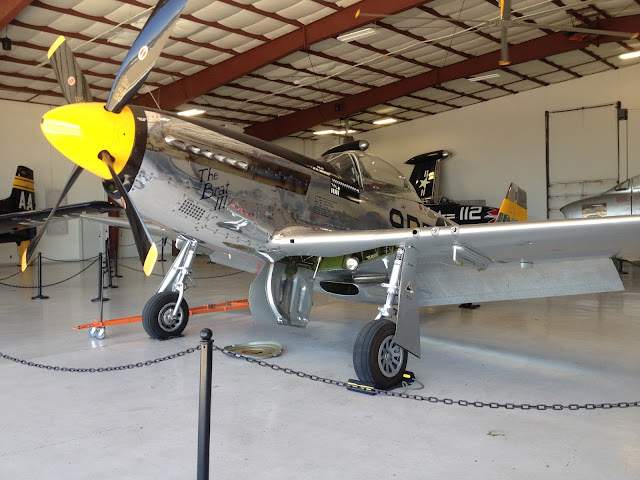The municipal airport in Addison, Texas, is home to a great many aeronautical businesses as well as hosting a huge number of corporate clients that maintain a presence in the Frisco/Plano/Greater Dallas Metro area. It is also just a few miles from our home base in Frisco, and is the home of the Cavanaugh Flight Museum.
Founded by Jim Cavanaugh in 1993, the museum contains over 40 aircraft from WWI, WWII, Korea, and Vietnam, most of which are fully restored and operational. Several civilian aircraft are also represented. From the welcome desk, the museum begins in Hangar One with a collection of WWI aircraft nestled under the wings of a B-25.
This 1917 Sopwith Camel is painted in the colors of Capt. A. Roy Brown of the Royal Canadian Air Force, who is credited with shooting down Baron Von Richtofen (The Red Baron) in this airplane. It has been restored using original factory drawings and is completely authentic. The Camels were beyond state of the art in WWI, and dominated the skies over Europe.
This B-24, "How Boot That" was built in Kansas City in 1944, and flew 82 missions in Italy from September 1944 to April 1945. After the war, this plane served as a trainer for years, and eventually was designated for the scrapyard. Surfacing again for the movie "Catch 22", it enjoyed brief notoriety, and ended up atop a pole in a cemetery in Pittsburgh, Pennsylvania. Purchased in 1992 by Cavanaugh Flight, it was trucked to Chino, California for a 2 1/2 year restoration. All of the aircrafts system are original and fully operational. The planes nose art, based on an Alberto Varga print, was first painted by Jack Kawalik, an instrument specialist with the 310th group, in December of 1944. Mr. Kawalik repainted his creation fifty years later at the Cavanaugh Flight Museum, in July 1995. The attention to detail and authenticity of this plane has been rewarded by being named Grand Champion Warbird at the E.A.A. Oshkosh Air Show in 1995.
This Fokker Dr. 1 is one of the most recognized planes of WWI. Built in response to the Sopwith Camels, this particular airplane was delivered to the Red Baron, Rittmeister Manfred von Richtofen by Tony Fokker in August, 1917. Several design flaws resulted in the quick introduction of the Dr. 2, which is on display in the museum also.
The F105F ThunderChief was designed to be a nuclear attack bomber, carrying a single nuclear bomb in an internal bomb bay. It was a brutally large, powerful and effective fighter/bomber that was used over Vietnam in a role for which it was not designed. The F105 (commonly known as "The Thud") flew more missions over Vietnam and suffered more losses than any other aircraft. It was used as a decoy to flush out communist SAM;s, a very effective, but costly, role.
This Messerschmitt Me 109 is probably the best know of the WWII Luftwaffe aircraft. This particular plane uses a Rolls Royce engine because the Junkers Jumbo 210 engine was not available early in the war.
The P-51D Mustang is probably the best know fighter aircraft of all time. Requested by the British, it first saw battle in 1942, and was not retired until four decades later, an unmatched service record. Originally equipped with an Allison engine, it performed well at altitudes under 12,000 feet, but underperformed over that. A new Rolls Royce Merlin engine was created, with supercharging which gave the Mustang new legs and extended its service life.
"The Girls":
While this FG-1D Corsair, one of the most recognizable of the Navy's WWII planes, is ready to fly, and indeed rides are given on specified days ($2500 for 30 min).
This O2-A Skymaster doesn't appear to be flight ready! This particular plane was assigned to the 504th TAAS at Da Nang Air Force Base, Vietnam, in November 1967. As a Forward Air Control aircraft, this plane suffered a number of attacks from ground fire; a total of 10 bullet holes and shrapnel holes were repaired during it's stay in southeast asia. It is being restored by volunteers at the Museum.
After several happy hours outside on the tarmac, as well as inside the four hangers open to the public, we ventured into the art gallery, where many wonderful paintings are on display, including this rendering of a B-17 raid over Europe.
Returning to Nessie for some afternoon chores, we stopped at a grocery store to fill up Gus with gas!
The weather was clear and warm (96 deg at 4 pm), and perfectly Texas-flat.
Lewisville Lake doesn't look like it flooded half the town and caused billions in damages!
Later in the evening, we enjoyed a very special Italian dinner at one of the restaurants favored by our friends, Roger and Mary. Their friends Del and Linda joined us and we all had a great meal and some wonderful conversation. Thanks, guys!













No comments:
Post a Comment